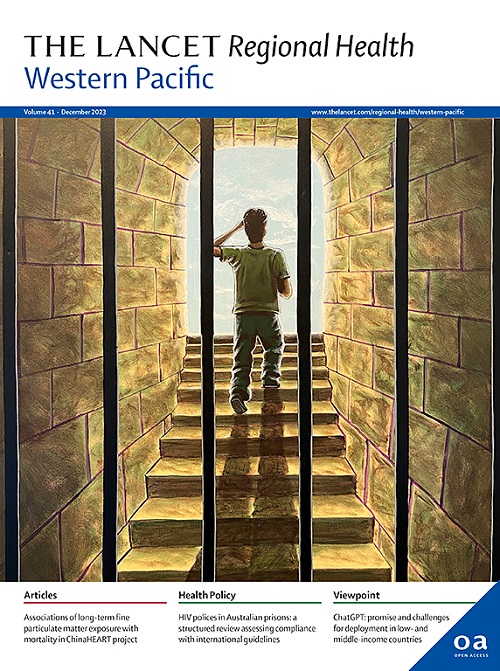The association between sexually transmitted infections and pregnancy outcomes in the Northern Territory, Australia: a population-based cohort study
IF 8.1
1区 医学
Q1 HEALTH CARE SCIENCES & SERVICES
引用次数: 0
Abstract
Background
Often asymptomatic in nature, sexually transmitted infections (STIs) are highly prevalent in women of reproductive ages, leading to adverse perinatal outcomes. This study investigated the association between STIs during pregnancy and the risk of adverse perinatal outcomes using comprehensive population-linked data from the Northern Territory (NT), Australia.
Methods
This population-based retrospective cohort study examined births (live births and stillbirths) from the NT Perinatal Data Collection and the NT Notifiable Diseases register from 2005 to 2020. All singleton births (N = 59,465) were included, along with infectious disease notifications of four STIs that occurred during pregnancy: chlamydia, gonorrhoea, trichomoniasis, and syphilis. Relative risks (RR) for associations between STIs during pregnancy with adverse perinatal outcomes (pre-labour rupture of membranes, preterm birth, small-for-gestational age, stillbirth) were estimated using robust Poisson regression models.
Findings
For babies born with congenital syphilis (n = 23), there was an association with preterm birth (RR 3.34, 95% confidence interval (CI) 1.80–6.17) and small-for-gestational age (RR 2.22, 95% CI 1.34–3.67). Small-for-gestational age was associated with maternal chlamydia (RR 1.86, 95% CI 1.54–2.24), maternal gonorrhoea (RR 1.76, 95% CI 1.46–2.12), and maternal trichomoniasis (RR 1.10, 95% CI 1.01–1.20). Associations were also observed between gonorrhoea and stillbirth (RR 1.97, 95% CI 1.19–3.27), and trichomoniasis with preterm birth (RR 1.23, 95% CI 1.09–1.39).
Interpretation
STIs during pregnancy showed notable associations with adverse birth outcomes. Congenital syphilis most severely affected outcomes, tripling preterm birth risk and doubling small-for-gestational age risk. These findings underscore the importance of addressing barriers to STI screening and treatment prior to and during pregnancy.
Funding
National Health and Medical Research Council and the Western Australian Future Health Research and Innovation Fund.
澳大利亚北部地区性传播感染与妊娠结局之间的关系:一项基于人群的队列研究
性传播感染(STIs)通常无症状,在育龄妇女中非常普遍,导致不良的围产期结局。本研究利用来自澳大利亚北领地(NT)的综合人口相关数据,调查了怀孕期间性传播感染与不良围产期结局风险之间的关系。方法本以人群为基础的回顾性队列研究调查了2005年至2020年来自北领地围产期数据收集和北领地法定疾病登记的新生儿(活产和死产)。所有单胎分娩(N = 59,465)被纳入研究,同时还包括怀孕期间发生的四种性传播感染的传染病报告:衣原体、淋病、滴虫病和梅毒。使用稳健泊松回归模型估计妊娠期性传播感染与不良围产期结局(产前胎膜破裂、早产、胎龄小、死胎)相关的相对风险(RR)。发现先天性梅毒患儿(n = 23)与早产(RR 3.34, 95%可信区间(CI) 1.80-6.17)和胎龄小(RR 2.22, 95% CI 1.34-3.67)相关。小胎龄与母体衣原体感染(RR 1.86, 95% CI 1.54-2.24)、母体淋病(RR 1.76, 95% CI 1.46-2.12)和母体滴虫病(RR 1.10, 95% CI 1.01-1.20)相关。淋病与死产(RR 1.97, 95% CI 1.19-3.27)和滴虫病与早产(RR 1.23, 95% CI 1.09-1.39)之间也存在关联。妊娠期性传播感染与不良分娩结局显著相关。先天性梅毒对预后影响最严重,使早产风险增加两倍,小胎龄风险增加一倍。这些发现强调了在怀孕前和怀孕期间解决性传播感染筛查和治疗障碍的重要性。资助国家卫生和医学研究委员会和西澳大利亚未来卫生研究和创新基金。
本文章由计算机程序翻译,如有差异,请以英文原文为准。
求助全文
约1分钟内获得全文
求助全文
来源期刊

The Lancet Regional Health: Western Pacific
Medicine-Pediatrics, Perinatology and Child Health
CiteScore
8.80
自引率
2.80%
发文量
305
审稿时长
11 weeks
期刊介绍:
The Lancet Regional Health – Western Pacific, a gold open access journal, is an integral part of The Lancet's global initiative advocating for healthcare quality and access worldwide. It aims to advance clinical practice and health policy in the Western Pacific region, contributing to enhanced health outcomes. The journal publishes high-quality original research shedding light on clinical practice and health policy in the region. It also includes reviews, commentaries, and opinion pieces covering diverse regional health topics, such as infectious diseases, non-communicable diseases, child and adolescent health, maternal and reproductive health, aging health, mental health, the health workforce and systems, and health policy.
 求助内容:
求助内容: 应助结果提醒方式:
应助结果提醒方式:


